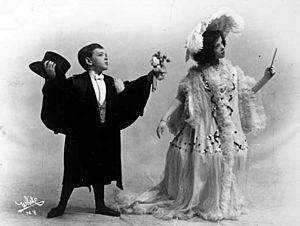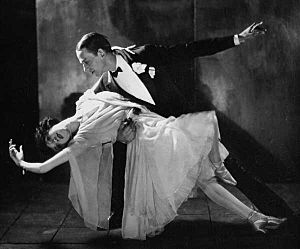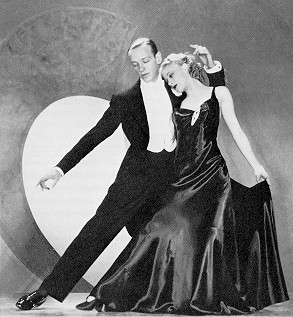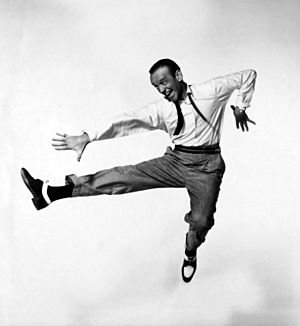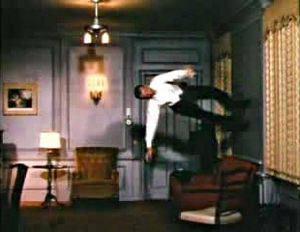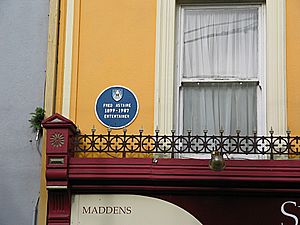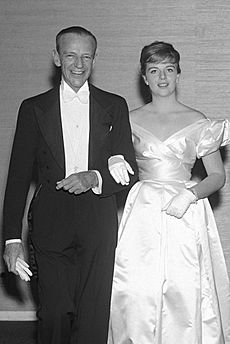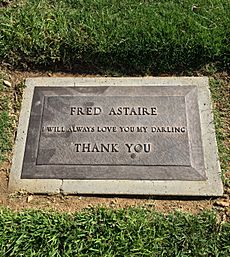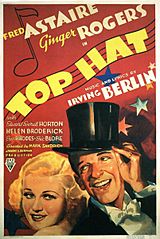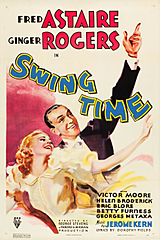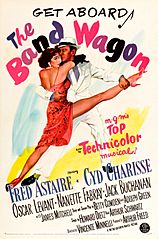Fred Astaire facts for kids
Quick facts for kids
Fred Astaire
|
|
|---|---|
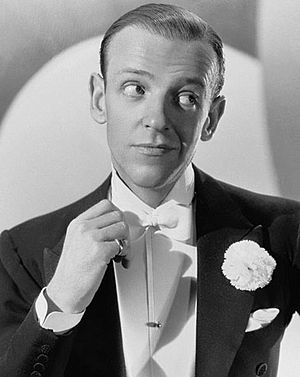
Astaire in 1941
|
|
| Born |
Frederick Austerlitz
May 10, 1899 Omaha, Nebraska, U.S.
|
| Died | June 22, 1987 (aged 88) Los Angeles, California, U.S.
|
| Resting place | Oakwood Memorial Park Cemetery |
| Occupation |
|
| Years active | 1904–1981 |
| Spouse(s) |
Phyllis Livingston Potter
(m. 1933; died 1954)Robyn Smith
(m. 1980) |
| Children | 2 |
| Relatives | Adele Astaire (sister) |
| Awards | Full list |
| Musical career | |
| Instruments |
|
| Labels |
|
Fred Astaire (born Frederick Austerlitz; May 10, 1899 – June 22, 1987) was an American dancer, choreographer, actor, and singer. Many people call him the "greatest popular-music dancer of all time." He won many awards, including an Academy Honorary Award, three Primetime Emmy Awards, a BAFTA Award, and two Golden Globe Awards. He also received a Grammy Award.
Astaire's career in stage, film, and television lasted for 76 years. He performed in over 10 Broadway and West End musicals. He also made 31 musical films and four television specials. As a dancer, he was famous for his amazing sense of rhythm and his desire to be perfect. His most famous dance partner was Ginger Rogers. They starred together in 10 Hollywood musicals. Some of their most famous films include Top Hat (1935) and Swing Time (1936). The American Film Institute named Astaire the fifth-greatest male star of Classic Hollywood cinema.
Contents
Life and Career of Fred Astaire
Early Life and First Steps in Show Business (1899–1916)
Fred Astaire was born Frederick Austerlitz on May 10, 1899, in Omaha, Nebraska. His mother, Johanna, dreamed that her children would become famous. Fred's older sister, Adele, was a natural dancer and singer. Johanna decided to create a "brother and sister act" for them. This type of act was very popular in vaudeville shows at the time.
At first, Fred did not want to take dance lessons. But he soon started copying his sister's dance moves easily. He also learned to play the piano, accordion, and clarinet. In 1905, the family moved to New York City to start the children's show business careers. They began training at a special theater school.
Fred and Adele's mother suggested they change their last name to "Astaire." She thought "Austerlitz" sounded too much like the Battle of Austerlitz. Their first act was called Juvenile Artists Presenting an Electric Musical Toe-Dancing Novelty. Fred often wore a top hat to make him look taller. In November 1905, their act debuted in Keyport, New Jersey. A local newspaper called them "the greatest child act in vaudeville."
As they grew older, Adele became taller than Fred. This made their act look a bit strange. So, the family took a two-year break from performing. When they returned, they added tap dancing to their routines. Fred was inspired by famous dancers like Bill Robinson and John W. Bubbles. They also learned ballroom dances like the tango and waltz.
By age 14, Fred was in charge of the music for their act. In 1916, he met George Gershwin, a young composer. This meeting was very important for both of their careers. Fred was always looking for new dance ideas and ways to make his performances perfect.
Broadway and London Stage Success (1917–1933)
The Astaire siblings became famous on Broadway in 1917 with a show called Over the Top. They also performed for soldiers during this time. Critics praised Fred's dancing. One writer said, "Fred Astaire stood out... He and his partner, Adele Astaire, made the show pause early in the evening with a beautiful loose-limbed dance."
Adele was known for her charm and humor. But Fred's dancing skills began to shine even more. Throughout the 1920s, Fred and Adele were very popular in New York and London. They starred in hit shows like Lady, Be Good (1924) and Funny Face (1927). Fred's tap dancing was considered among the best in the world.
In 1932, Adele married and left the act. This was a difficult time for Fred. But it also pushed him to try new things on his own. He starred in a Broadway show called Gay Divorce. In this show, he created a romantic dance with his new partner, Claire Luce. This dance to Cole Porter's "Night and Day" was a huge success. It helped start a new style of dance in movies.
Fred Astaire and Ginger Rogers at RKO (1933–1939)

When Fred Astaire first tried out for movies at RKO Radio Pictures, a report supposedly said: "Can't sing. Can't act. Balding. Can dance a little." Fred later said it actually read: "Can't act. Slightly bald. Also dances." Even so, the studio saw his charm.
His first big Hollywood movie was Dancing Lady (1933) at MGM. He danced with Joan Crawford in it. When he returned to RKO, he was paired with Ginger Rogers in Flying Down to Rio (1933). Fred was not keen on being part of another dance team after working with his sister for so long. But the public loved him and Ginger together.
Their partnership, along with choreographer Hermes Pan, made dancing a very important part of Hollywood musicals. Fred and Ginger made nine films together at RKO. These included The Gay Divorcee (1934), Top Hat (1935), and Swing Time (1936). Six of their nine musicals were the biggest money-makers for RKO. Their films also brought a lot of respect and art to the studio.
New Ideas in Filmed Dance
Fred Astaire changed how dance was filmed. He had two main rules:
- He wanted the camera to film dance routines with as few cuts as possible. The camera would follow the dancers closely, keeping them in full view. This made it seem like you were watching a live stage performance. He famously said, "Either the camera will dance, or I will."
- He insisted that all songs and dances should be part of the movie's story. They weren't just separate performances. Instead, dance helped move the plot forward.
His dance sequences allowed viewers to fully enjoy the dancers and their moves. This was different from other musicals at the time, which often used many quick cuts and close-ups.
Working with Ginger Rogers
Many dance experts and even Fred Astaire himself believed Ginger Rogers was his best dance partner. Fred said, "Ginger had never danced with a partner before Flying Down to Rio. She faked it an awful lot. She couldn't tap and she couldn't do this and that... but Ginger had style and talent and improved as she went along." He also said, "Ginger was brilliantly effective. She made everything work for her. Actually, she made things very fine for both of us and she deserves most of the credit for our success."
Despite their success, Fred did not want his career to be tied only to one partner. He tried making a film on his own, A Damsel in Distress (1937). It was not as successful. He then made two more films with Ginger, Carefree (1938) and The Story of Vernon and Irene Castle (1939). After these, Fred left RKO. He reunited with Ginger Rogers one last time in 1949 for The Barkleys of Broadway.
New Partners and Brief Retirement (1940–1947)
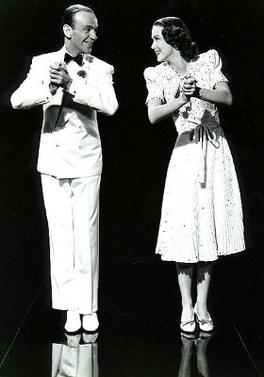
After leaving RKO, Fred Astaire worked with many new dance partners. He always looked for new ways to dance. His first partner after Ginger was Eleanor Powell, who was known as an amazing female tap-dancer. They starred in Broadway Melody of 1940. Fred said about her, "She 'put 'em down' like a man, no ricky-ticky-sissy stuff with Ellie. She really knocked out a tap dance in a class by herself."
He also appeared with Bing Crosby in Holiday Inn (1942) and Blue Skies (1946). Holiday Inn is famous for his amazing solo dance to "Let's Say it with Firecrackers." Blue Skies featured his iconic "Puttin' On the Ritz" routine.
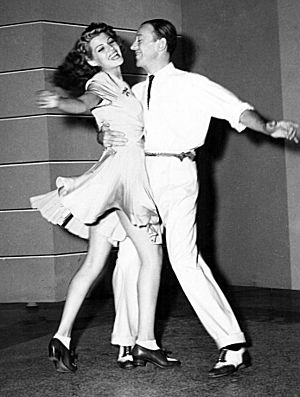
Fred made two movies with Rita Hayworth. The first, You'll Never Get Rich (1941), made Hayworth a big star. In this film, Fred added Latin American dance styles to his moves. His second film with Hayworth, You Were Never Lovelier (1942), was also a hit.
His next film was The Sky's the Limit (1943) with Joan Leslie. In this movie, he performed "One for My Baby" with a dark and emotional dance on a bar counter. This was a different kind of role for Fred.
He then worked with Lucille Bremer in two big movies. Yolanda and the Thief (1945) had a unique, dream-like ballet. In Ziegfeld Follies (1945), he danced with Gene Kelly.
Feeling unsure about his career, Fred announced his retirement in 1946 during the making of Blue Skies. He said "Puttin' on the Ritz" would be his last dance. After retiring, he focused on his horse-racing hobby. In 1947, he started the Fred Astaire Dance Studios, which he later sold.
Return to Film and Television (1948–1981)
Fred Astaire's retirement did not last long. He returned to movies to replace an injured Gene Kelly in Easter Parade (1948) with Judy Garland. He then had one last reunion with Ginger Rogers in The Barkleys of Broadway (1949). Both films were very popular and brought Fred back into the spotlight.
He starred in several more musicals, including Royal Wedding (1951) with Jane Powell, which was very successful. The Band Wagon (1953) received great reviews. In 1954, his wife Phyllis sadly passed away. Fred was heartbroken and wanted to stop filming Daddy Long Legs (1955). But his friends convinced him that working would help him heal.
He also starred with Audrey Hepburn in Funny Face (1957) and with Cyd Charisse in Silk Stockings (1957). After these films, Fred announced he was retiring from dancing in movies. He had made 30 musical films in 25 years.
Fred did not stop dancing completely. He made four popular TV specials between 1958 and 1968. He danced with Barrie Chase in these shows. The first special, An Evening with Fred Astaire (1958), won nine Emmy Awards. Fred won an Emmy for "Best Single Performance by an Actor."
He also took on serious acting roles without dancing. He was nominated for a Golden Globe for his role in the drama On the Beach (1959). His last major musical film was Finian's Rainbow, directed by Francis Ford Coppola. Fred played an Irish character and sang with Petula Clark.
In the 1970s, Fred continued to act. He appeared in the movie The Towering Inferno (1974) and received his only Academy Award nomination for Best Supporting Actor. He also voiced the mailman in the animated TV specials Santa Claus Is Comin' to Town (1970) and The Easter Bunny Is Comin' to Town (1977).
In 1979, he made a special guest appearance on the science-fiction TV series Battlestar Galactica. He did this because his grandchildren loved the show. This episode was the last time he danced on screen. His final film was the horror movie Ghost Story (1981).
How Fred Astaire Changed Dance in Movies
Fred Astaire was an amazing dancer. He could show light-hearted fun or deep feelings with his movements. His control and sense of rhythm were incredible. For example, in the movie The Belle of New York, he filmed a dance number. Later, they decided to reshoot it because his costume and the set were too plain. When you watch both versions side-by-side, they are exactly the same, showing his perfect precision.
Astaire's dancing was known for its elegance, grace, and originality. He combined different styles, like tap dance, classical dance, and ballroom dance. He called his unique style "outlaw style" because it was an unexpected mix of his own artistic ideas. His dances looked simple, but they were very clever and detailed. Dancer Jerome Robbins said, "Astaire's dancing looks so simple, so disarming, so easy, yet the understructure... is so surprising and inventive."
Fred Astaire was the main choreographer for almost all his dance routines. He welcomed ideas from others, especially his main helper, Hermes Pan. But dance historians believe Fred was always the lead choreographer. He had choreographed all his routines with his sister Adele on Broadway.
Fred often didn't take credit for choreography in movies. He usually left the credit to his collaborators. But later in life, he admitted, "I had to do most of it myself."
Many of his dance sequences were built around a clever "gimmick." For example, he danced on the walls in Royal Wedding and with his shadows in Swing Time. He and his team would spend weeks practicing in a private rehearsal space. They would perfect every move before filming began.
Fred was a perfectionist. He would rehearse and retake scenes many times. This could be hard on others. But it meant his performances were always flawless. He often doubted himself, saying, "I've never yet got anything 100% right. Still, it's never as bad as I think it is."
Even though he saw himself as an entertainer, his art was admired by many famous dancers. These included Gene Kelly, Mikhail Baryshnikov, and Michael Jackson. Famous ballet choreographer George Balanchine called him "the most interesting, the most inventive, the most elegant dancer of our times." Baryshnikov said he was "a genius... a classical dancer like I never saw in my life."
Fred Astaire's Influence on Popular Song
Fred Astaire was very humble about his singing. He often said he couldn't sing well. But critics thought he was one of the best. He introduced many famous songs from the Great American Songbook. These include:
- Cole Porter's "Night and Day" from Gay Divorce (1932)
- Irving Berlin's "Cheek to Cheek" and "Top Hat, White Tie and Tails" from Top Hat (1935)
- Jerome Kern's "The Way You Look Tonight" from Swing Time (1936)
- The Gershwins' "They Can't Take That Away from Me" from Shall We Dance (1937)
He also sang many classic duets with his partners. With his sister Adele, he introduced "Fascinating Rhythm" in Lady, Be Good (1924). With Ginger Rogers, he sang "Pick Yourself Up" and "A Fine Romance" in Swing Time (1936). With Judy Garland, he sang "A Couple of Swells" from Easter Parade (1948).
Even though his voice was light, people admired his clear words and musical style. Composer Burton Lane called him "the world's greatest musical performer." Irving Berlin thought Astaire was as good as any male singer for his songs. Many famous composers wrote songs especially for him.
Fred Astaire also wrote songs. His song "I'm Building Up to an Awful Letdown" reached number four on the music charts in 1936. He always wanted to be a successful songwriter. In 1952, he recorded The Astaire Story, an album that looked back at his career. This album won a Grammy Hall of Fame Award in 1999.
Awards, Honors, and Tributes
- 1938: Placed his hand and footprints in cement at Grauman's Chinese Theatre, Hollywood.
- 1950: Received an Academy Honorary Award for his unique art and contributions to musical films.
- 1950: Won a Golden Globe Award for Best Actor - Motion Picture Musical or Comedy for Three Little Words.
- 1958: Won an Emmy Award for "Best Single Performance by an Actor" for An Evening with Fred Astaire.
- 1960: Received the Golden Globe Cecil B. DeMille Award for his lifetime achievements in movies.
- 1960: Inducted into the Hollywood Walk of Fame.
- 1961: Won an Emmy Award for Astaire Time.
- 1972: Named Musical Comedy Star of the Century.
- 1972: Inducted into the American Theater Hall of Fame.
- 1975: Nominated for an Academy Award for The Towering Inferno. He also won a Golden Globe and BAFTA for this role.
- 1978: Won an Emmy Award for "Best Actor – Drama or Comedy Special" for A Family Upside Down.
- 1978: Was one of the first people to receive the Kennedy Center Honors.
- 1981: Received the Lifetime Achievement Award from the American Film Institute.
- 1987: Inducted into the National Museum of Dance's Hall of Fame.
- 1989: Received a Grammy Lifetime Achievement Award after his death.
- 1989: Inducted into the Television Hall of Fame after his death.
- 1999: His 1952 album The Astaire Story won a Grammy Hall of Fame Award after his death.
- 2000: A plaque honoring him was unveiled in Lismore, Ireland.
- The Dancing House in Prague is nicknamed "Fred and Ginger."
- Many songs mention Fred Astaire, including Madonna's "Vogue" and Hozier's "Movement."
Personal Life
Fred Astaire married Phyllis Potter in 1933. She was a socialite from Boston. They were married for 21 years until Phyllis sadly died from lung cancer in 1954. Fred was very sad after her death.
Fred and Phyllis had two children: a son, Fred Jr. (born 1936), and a daughter, Ava Astaire (born 1942). Ava continues to help promote her father's legacy.
Fred Astaire was a very private person. He rarely went to Hollywood parties. He preferred to spend his free time with his family and on his hobbies. These hobbies included horse racing, playing the drums, writing songs, and golfing. He was good friends with actors like David Niven and Clark Gable.
He stayed active even into his eighties. He started skateboarding when he was in his late seventies and even broke his wrist doing it! He also enjoyed boxing and true crime stories.
Fred Astaire was always dressed perfectly. He and Cary Grant were called "the best-dressed actor[s] in American movies." Even later in life, he was a fashion icon. He often wore tailored sport jackets, colored shirts, and slacks held up by an old tie instead of a belt.
In 1980, at age 81, he married for a second time to Robyn Smith. She was a jockey.
Fred Astaire never allowed his life story to be made into a movie. He said, "However much they offer me—and offers come in all the time—I shall not sell." His will even included a rule that no such portrayal should ever happen. He explained, "It is there because I have no particular desire to have my life misinterpreted, which it would be."
Death
Fred Astaire passed away from pneumonia on June 22, 1987, at the age of 88. He was buried at Oakwood Memorial Park Cemetery in Chatsworth, California. One of his last wishes was to thank his fans for their many years of support.
Fred Astaire's Work
Musical Films
- Dancing Lady (1933) { Joan Crawford }
- Flying Down to Rio* (1933)
- The Gay Divorcee* (1934)
- Roberta* (1935)
- Top Hat* (1935)
- Follow the Fleet* (1936)
- Swing Time* (1936)
- Shall We Dance* (1937)
- A Damsel in Distress (1937) { Joan Fontaine }
- Carefree* (1938)
- The Story of Vernon and Irene Castle* (1939)
- Broadway Melody of 1940 (1940) { Eleanor Powell }
- Second Chorus (1940) { Paulette Goddard }
- You'll Never Get Rich** (1941)
- Holiday Inn*** (1942)
- You Were Never Lovelier** (1942)
- The Sky's the Limit (1943) { Joan Leslie }
- Ziegfeld Follies (1945) { Lucille Bremer, Gene Kelly }
- Yolanda and the Thief (1945) { Lucille Bremer }
- Blue Skies*** (1946)
- Easter Parade (1948) { Judy Garland }
- The Barkleys of Broadway* (1949)
- Three Little Words**** (1950)
- Let's Dance (1950) { Betty Hutton }
- Royal Wedding (1951) { Jane Powell }
- The Belle of New York**** (1952)
- The Band Wagon* (1953)
- Daddy Long Legs (1955) { Leslie Caron }
- Funny Face (1957) { Audrey Hepburn }
- Silk Stockings* (1957)
- Finian's Rainbow (1968)
- That's Entertainment! (1974)
- That's Entertainment, Part II (1976) (narrator and performer)
- That's Entertainment! III (1994)
Performances with *Ginger Rogers (10), Rita Hayworth (2), ***Bing Crosby (2), ****Vera-Ellen (2), ***Cyd Charisse (2).
All performances with a { }, indicate the sole appearance of the performer as Astaire's partner.
Non-Musical Films
- On the Beach (1959)
- The Pleasure of His Company (1961)
- The Notorious Landlady (1962)
- Midas Run (1969)
- The Towering Inferno (1974)
- The Amazing Dobermans (1976)
- The Purple Taxi (1977)
- Ghost Story (1981)
Television Shows
- General Electric Theater (2 episodes) (1957, 1959)
- An Evening with Fred Astaire* (1958)
- Another Evening with Fred Astaire* (1959)
- Astaire Time* (1960)
- Alcoa Premiere (host) (1961–1963)
- Dr. Kildare (4 episodes) (1965)
- The Fred Astaire Show* (1968)
- It Takes a Thief (5 episodes) (1969–1970)
- Santa Claus Is Comin' to Town (narrator) (1970)
- The Easter Bunny Is Comin' to Town (narrator) (1977)
- A Family Upside Down (TV movie) (1978)
- The Man in the Santa Claus Suit (TV movie) (1979)
- Battlestar Galactica (1 episode) (1979)
*Performances with dancing partner Barrie Chase (7)
Images for kids
See also
 In Spanish: Fred Astaire para niños
In Spanish: Fred Astaire para niños


